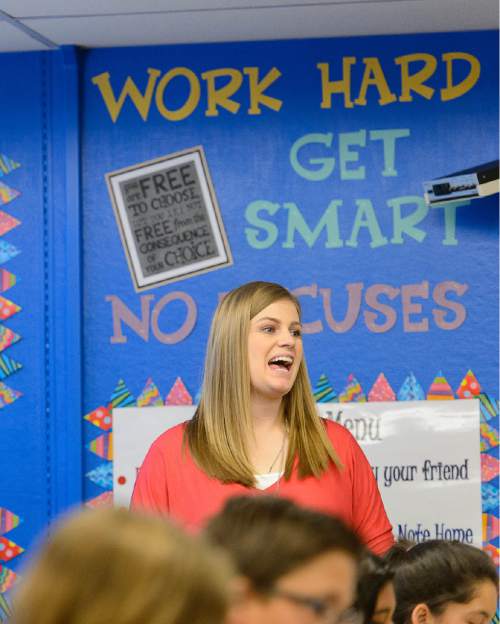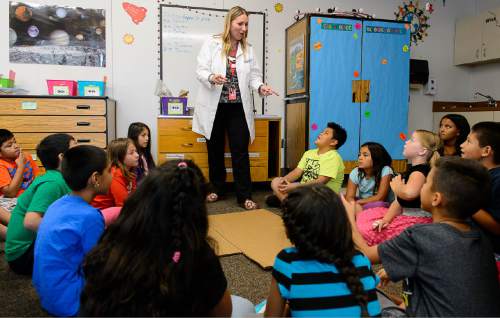This is an archived article that was published on sltrib.com in 2015, and information in the article may be outdated. It is provided only for personal research purposes and may not be reprinted.
Lincoln Elementary School science teacher Cara Baldree quizzed a group of fourth-graders on Friday while they created the Wasatch Mountains out of Play-Doh.
She asked about the state's three major ecosystems — marshy wetlands, dry deserts and elevated mountains — and what the brine shrimp in the Great Salt Lake like to eat.
"Allergies?" offered one student.
"That's right, algae," Baldree said with a subtle, but encouraging, correction.
Baldree is one of two new science teachers at the Salt Lake City elementary school, which until last year included teaching science with the other duties of a student's primary classroom teacher.
Principal Peggy Patterson said the shift has already generated results, giving children two hours each week of targeted science instruction while their regular teachers meet in planning groups.
And the proof is in the school's 2015 SAGE test results.
"Science scores doubled," Patterson said. "They're still pretty low, but doubling is good."
At Lincoln Elementary School, where children speak 22 native languages, 37 percent of students met grade-level benchmarks on year-end tests last spring, according to data released Monday by the Utah State Office of Education.
That's up from just 19 percent last year — a performance jump that helped Lincoln Elementary School earn special recognition as the most-improved school in Salt Lake City School District.
"The trajectory is going up," Patterson said. "There are some great things going on here."
New scores from Utah's computer-based SAGE testing system, which launched in 2014, show an upward trajectory for the majority of public schools across the state. The percentage of students scoring proficient in English, math and science increased to 44.1 percent, 44.6 percent and 46.8 percent, respectively.
Math scores jumped the most across Utah, improving 5.4 percentage points in the second year of SAGE testing.
That translates to roughly 21,000 additional students hitting grade-level expectations in mathematics.
"We're thrilled," said Jo Ellen Shaeffer, director of assessment and accountability for the Utah State Office of Education. "I think teachers and kids are really getting a handle on the [Utah] Core, and that's exciting to see."
Last year's SAGE debut was met with controversy, stemming from its computer- adaptive format and its alignment with new state core standards.
The unfamiliar system resulted in a sharp drop in year-end test scores, which state education managers said was a reflection of the new test and the rigor of new grade-level benchmarks designed to prepare students for success in college or a career after graduation.
The format for high school math also was altered, with different subjects presented each year instead of the traditional model of teaching algebra one year, geometry the next and, finally, calculus.
"We should see continued improvement — we better see continued improvement — as our teachers become more adept at teaching to this higher standard," said Granite School District spokesman Ben Horsley.
Proficiency rates in Granite increased to 31.7 percent in English, 32.7 percent in math and 31.2 percent in science — up from 28.6 percent, 28.1 percent and 28.9 percent, respectively.
Horsley said the district is pleased that scores are moving in the right direction. But teachers are aware that roughly two-thirds of their students continue to fall short.
"It's important to look at your individual students' SAGE data and then work closely with the teacher if you have questions about that," he said.
While the general statewide trend was improved scores, several schools and school districts saw their proficiency rates drop.
Tintic School District had decreased proficiency rates in all three SAGE test subjects, as did several charter schools, including Bear River Charter School, Dual Immersion Academy, Lakeview Academy, Odyssey Charter School, Spectrum Academy, Summit Academy and Utah Virtual Academy.
Charter schools are listed as individual school districts for the purposes of Utah State Office of Education oversight and accountability. Several charter school administrators did not respond to requests for comment.
Alta High School math teacher Becky Waters said there continues to be angst related to "integrated" math and SAGE testing, despite the increase in scores.
"There's still very strong feelings about it," she said. "I don't know if that's ever really going to go away."
She said a lot of students were succesful under the old algebra-geometry-calculus math sequence. But she's also seen a general increase in the ability to problem solve under the new integrated approach.
"My past students would give up much quicker," she said. "I've seen a definite change in how well my students are prepared for story problems at the harder-level classes."
Patterson said she supports the change to SAGE and the new Utah Core. Data from the new testing system can be an asset for teachers, highlighting weaknesses and helping to tailor instruction.
"The data analysis is key," she said. "It's looking at 'What don't they know, and why don't they?' "
SAGE scores for the state, school districts and individual schools are available on the Utah State Office of Education website.
Scores also will be used to calculate grades for the state's school-grading program and for the governor's PACE Report Cards, which are both scheduled to be released Sept. 15.





